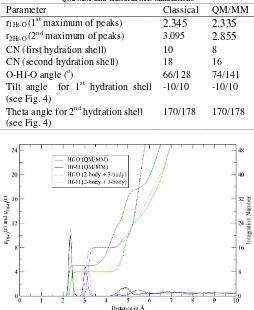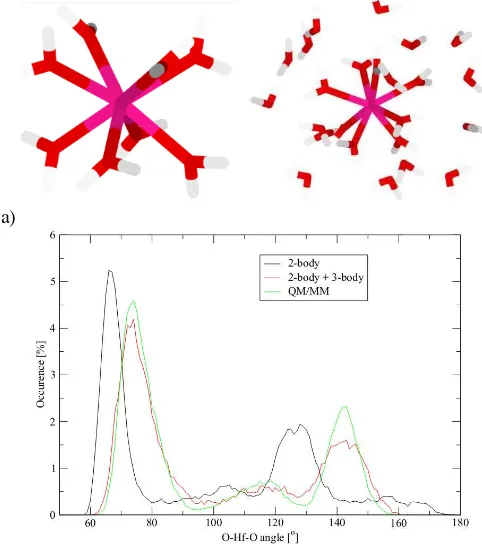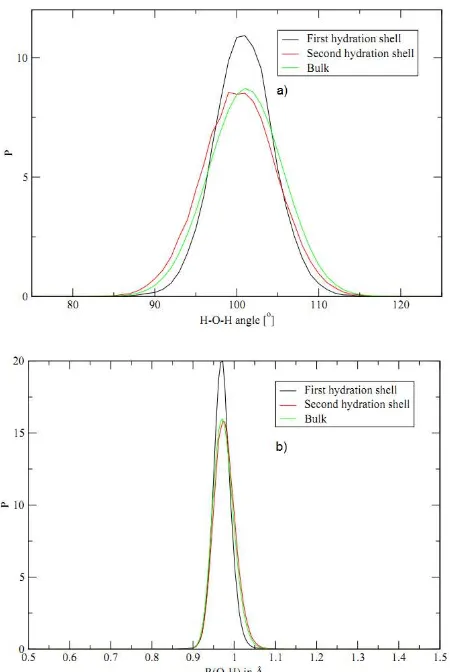The Third Basic Science International Conference - 2013 C15-1
Abstract— An ab initio 2-body analytical potential function was constructed to describe Hf(IV)-water interactions. Classical and combined QM/MM molecular dynamics (MD) simulations have been performed to study the structure of the hydrated Hf(IV) ion. The influence of 3-body and higher (n-body) terms were investigated. The hydration structure of Hf(IV) is discussed in terms of radial distribution functions (RDF), coordination numbers (CND), and angular distribution functions (ADF). The results of the QM/MM MD simulations have been found in good agreement with experimental values, proving that 3-body and n-body effects play an important role in the description of the structure of the hydrated Hf(IV) ion.
Keywords: Terms—2-body potential, Hf(IV) ion, hydration, QM/MM approach
I. INTRODUCTION
afnium and zirconium coexist in nature. Both of them are used in nuclear reactors. Zirconium is used as a structural and container material while hafnium as a control material in water-cooled nuclear reactors. It is well known those elements have very similar chemical properties and are referred to as chemical isotopes [3]. Hafnium has a high thermal neutron capture while pure or reactor-grade zirconium (hafnium-free) has a low neutron capture; hence, for most nuclear applications, reactor-grade zirconium is required. For this reason, it is necessary to separate the hafnium from the zirconium, although complicated separation methods are required to remove the hafnium. One of that separation methods is solvent extraction. The reaction for the extraction of the metal ion may be expressed as follows [3]:
)
Manuscript delivered April 6, 2013. This work was supported in part by the Indonesian Government through the Directorate General of Higher Education, is gratefully acknowledged.
Suwardi is with the Dept. of Chemistry Education, Yogyakarta State University, Indonesia ( e-mail: suwardi@ uny.ac.id).
Pranowo, H.D., is with Austrian-Indonesian Centre for Computational Chemistry, Dept. of Chemistry, Gadjah Mada University, Indonesia (e-mail: [email protected]).
Armunanto, R., is with Austrian-Indonesian Centre for Computational Chemistry, Dept. of Chemistry, Gadjah Mada University, Indonesia (e-mail: [email protected]).
It is clear that more easily Mz+ ions enter in organic phase more larger Mz+ ions can be extracted. However, Mz+ ions in water undergo hydration so that the simple or not extraction will depend on the structure of the hydration of Mz + ions. The rigidity of the structure of hydration caused Mz + ions hard to get out of the water phase.
The EXAFS studies of Hf(OH2)84+ solvation structures [6], if the QM/MM approach is performed to include many-body effects, using at least double zeta basis sets for the Hartree–Fock ab initio treatment of the quantum mechanical region. In this paper, we focused on study of structure of hydrated Hf(IV) ion by an ab initio QM/MM approach.
II. METHODS 2.1. Potential Functions.
The 2-body potential for the Hf(IV)–water interaction was newly constructed, applying DZP basis sets for oxygen and hydrogen and the modified LANL2DZ ECP basis for hafnium[15]. More than 8000 Hartree–Fock interaction energy points cal-culated by the TURBOMOLE 5.10 program were fitted to an analytical form by a least square error minimization using the Levenberg–Marquardt algorithm[1]:
)
Structure of Hf(IV) in aqueous solution - An ab initio
QM/MM MD approach
Suwardi, Harno Dwi Pranowo, and Ria Armunanto
The Third Basic Science International Conference - 2013 C15-2
Table 1 Final optimized parameters for the interactions of O and H atoms of water with Hf(IV)
AO
(kkal/mol Å5) (kkal/mol ÅBO 9) (kkal/mol ÅCO 11) (kkal/mol ÅDO 12) -9871.767 385214.691 -1706235.375 1463076.988
AH
(kkal/mol Å4) (kkal/mol ÅBH 5) (kkal/mol ÅCH 6) (kkal/mol ÅDH 12) -570.786 2674.223 -2092.776 284.542
More 17000 water–Hf(IV) ion–water configurations were used in the construction of the body potential. The resulting 3-body energies were fitted to the following functional form to be used as a correction for the 2-body potential [8,9]
)
r
is the oxygen–oxygen distance between both water molecules. The cutoff radius rcut is set to 6.0 Å after which three-body effects are negligible. The last, quadratic term ensures that energy and forces smoothly approach zero at rcut. The optimized parameters A1, A2, and A3 are listed in Table 2.Table 2 The optimized parameters A1, A2, and A3 for interactions H2O-Hf-H2O
A1(kkal/mol) A2(Å-1) A3(Å-1)
0.1080313 0.3089268 -0.2259769
2.2. QM/MM–MD simulation
The system consisted of one Hf(IV) ion and 499 water molecules in a periodic cube at a temperature of 298.16 K and constant volume. The radial cutoff limit was set to 12.0 Å. The quantum mechanical region includes metal ion and first shell was given a radius of 3.8 Å in accordance with RDF data from classic MD simulations with pair potential plus three-body
corrections. A reaction field was established to properly
account for long-range Coulombic interactions, and the density of 0.99702 g cm-3 was assumed to be the same as that of pure
water. The reaction field method was used to correct the cutoff
of long-range electrostatic interactions. The Newtonian equations of motion were treated by a predictor–corrector algorithm. A time step of 0.2 fs was chosen, since the BJH-CF2 water model allows explicit hydrogen movements [1,4,10,11].
The simulation was carried out with the QM/MM–MD program developed in Austrian-Indonesian Centre for Computational Chemistry for the calculation of the ab initio forces in the QM region. The basis sets used for evaluation of QM forces were the same as in the calculation of the 2-body
and 3-body potential functions. The system was equilibrated with a starting configuration obtained from a previous classical MD simulation. Data for structural evaluation was sampled within 12.0 ps.
III. RESULTS AND DISCUSSION
The Hf-O and Hf-H radial distribution functions (RDFs) and their running integration numbers obtained from classical and QM/MM simulations are displayed in Figure 1 and the main structural parameters are listed in Table 3. The maximum occurence for the Hf-O and Hf-H distances in the first hydration shell obtained from the QM/MM simulation were observed at 2.335 and 2.855 Å. The Hf-O distance is in good agreement witn experimental values (2.2 ± 0.02Å)[7].
Table 3 Hydration parameters for Hf(IV) in water obtained from QM/MM and classical MD simulations
Parameter Classical QM/MM
r1Hf-O (1st maximum of peaks)
2.345
2.335
r2Hf-O (2nd maximum of peaks) 3.0952.855
Theta angle for 2nd hydration shell(see Fig. 4)
170/178 170/178
Fig. 1. Hf–O and Hf–H radial distribution functions and their running integration numbers for Hf(IV)–water obtained by QM/MM–MD simulations.
The Third Basic Science International Conference - 2013 C15-3
ligand migration occurs from the first hydration shell to the second hydration shell or vice versa.
Figure 2. Variation of Hf(IV) ion-oxygen distances during the QM/MM simulation, showing no exchange processes between the first and second hydration shells.
The running integration numbers as derived from the Hf–O RDF predict a first shell coordination number of 8. The running integration number of the Hf–H RDF at the first minimum is exactly twice as much supporting the notion of two clearly isolated hydration spheres. The Hf–O RDF also shows that the structure-making effect of the cation extends up to distances of about 7Å, but the lack of a correspondence to the broad third Hf–O peak in the Hf–H RDF shows these third shell effects to be rather weak. The classical 2-body potential simulation would predict a tenfold first hydration shell in clear contrast to the higher level QM/MM–MD simulation. Obviously, the simple form of Eq. (2) alone is not sufficient to properly describe the structure of this Hf(IV) ion. Hence, we concentrate on the QM/MM–MD simulation.
Fig. 3.First- and second-shell coordination number distribution of hydrated Hf(IV) obtained by classical-MD (only 2-body), and QM/MM–MD simulations.
The detailed coordination number distributions from first and second shells are shown in Fig. 3. The first hydration shell exhibits 100% of octacoordination. The second shell, in contrast, is rather dynamic with appreciable populations ranging from 14 to 20, indicating a rapid exchange with the bulk (compare to the strongly non-zero RDF at the minimum
after the second peak). The highest occurence of coordination number of the second hydration shell is 16, i.e. every water in the first shell binds to 2.0 water molecules in the second shell.
The O–Hf–O angular distribution is displayed in Fig. 4.The main peaks are located near 74 and 141o, which represents an almost perfect square antiprismatic geometry. In addition, the peaks are clearly separated from each other showing the low inter-shell flexibility of the first shell, i.e. the water ligands are
kept well apart in the field of the metal ion [4,13].
a)
b)
Fig. 4. A) Snapshot of structures of hydrated Hf(IV) (first shell, and also second shell) showing coordination numbers of eight; b) Angular distribution function of the O–Hf–O angle in the first hydration shell.
The orientation of the water molecules relative to the ion may be concluded from the vector between the dipole moment and the V–O connection vector (theta angle) which gives further insight into the hydrates structure[14]. We observe an angle distribution with a maximum at 172o with tailing towards approximately 150o, showing a relatively low degree of
flexibility of the first shell ligands (Fig. 5). The distribution of
the tilt angle (angle between Hf-O connection vector and plane formed by O-H vectors) shows a narrow peak with its maximum at 0o and reaching zero at ±30o. Compared to the tilt angle of La(III)-H2O reaches zero at ±50o, Hf(IV) ion shows a
The Third Basic Science International Conference - 2013 C15-4
Fig. 5. Tilt-angle and theta-angle distributions of the Hf–H2O geometry.
The values of H–O–H angles and O–H distances with the highest occurence in the first hydration shell are 101o and 0.9725 Å, respectively as shown in Fig. 6.
Fig. 6. a) The angle and b) bond-length distribution of water molecules in the
first (black line) and second (red line) hydrations shell and in bulk (green line)
The inclusion of many-body effects in the QM region does not indicates H-O-H angle and O-H distances in the first hydration shell are significantly different compared with those in second hydration shell and bulk [5].
IV. CONCLUSION
Accordingly the results of QM/MM MD simulations, the structure of hydrated Hf(IV) ion is rigid, i.e low degree of flexibility of the ligands in the first hydration shell. This is a reason why the extraction of Hf(IV) ion in water is difficult to performed. Here, we also want to stress the importance of structural data to understand basic process in solutions, especially the equilibria process in solvent extraction.
REFERENCES
[1] Armunanto, R., Schwenk, C. F., dan Rode, B. M., 2003, Structure and dynamics of hydrated Ag (I): Ab initio quantum mechanical-molecular mechanical molecular dynamics simulation, J. Phys. Chem. A, 107,
3132–3138.
[2] Hagfeldt, C., Kessler, V., dan Persson, I., 2004, Structure of the hydrated, hydrolysed and solvated zirconium(IV) and hafnium(IV) ions in water and aprotic oxygen donor solvents. A crystallographic, EXAFS spectroscopic and large angle X-ray scattering study, Dalton
Transactions, 14, 2142–2151.
[3] Lee, H.Y., Kim, S.G., and Oh, J.O., 2004, Stoichiometric relation for extraction of zirconium and hafnium from acidic chloride solutions with Versatic Acid 10, Hydrometallurgy, 73, 91–97.
[4] Loeffler, H.H., Yague, J.I., Rode, B.M., 2002, QM/MM–MD simulation of hydrated vanadium(II) ion, Chemical Physics Letters, 363,
367–371
[5] Remsungnen, T, dan Rode, B.M., 2003, Dynamical properties of the water molecules in the hydration shells of Fe(II) and Fe(III) ions: ab initio QM/MM molecular dynamics simulations, Chemical Physics Letters, 367, 586–592
[6] Hofer, T. S., Randolf, B. R., dan Rode, B. M., 2006, Sr(II) in Water: A Labile Hydrate with a Highly Mobile Structure, J. Phys. Chem. B, 110, 20409-20417
[7] Brendle , J.M., L. Khouchaf , L., J. Baron, J., R. Le Dred, R.L., Tuilier, M.H., 1997, Zr-exchanged and pillared beidellite: preparation and characterization by chemical analysis, XRD and Zr K EXAFS,
Microporous Materials 11, 171–183
[8] Kritayakornupong, C., 2007, Ab initio QM/MM molecular dynamics simulations of Ru3+ in aqueous solution,
Chemical Physics Letters,441,
226–231
[9] Durdagi, S., Hofer, T.S., Randolf, B.R., and Rode, B.M., 2005, Structural and dynamical properties of Bi3+ in water, Chemical Physics
Letters, 406, 20–23
[10] Azam, S.S., Hofer, T.S., Randolf, B.R., and Rode, B.M., 2009, Hydration of Sodium(I) and Potassium(I) Revisited: A Comparative QM/MM and QMCF MD Simulation Study of Weakly Hydrated Ions, J.
Phys. Chem. A, 113, 1827–1834
[11] Hofer, T. S., Scharnagl, H., Randolf, B. R., and Rode, B. M., 2006, Structure and dynamics of La(III) in aqueous solution–An ab initio QM/MM MD approach, Chemical physics, 327, 31–42.
[12] Shah, S.A.A., Hofer, T.S., and Fatmi, M.Q., 2006, A QM/MM MD simulation study of hydrated Pd2+, Chemical Physics Letters 426, 301–
305
[13] Hofer, T. S., Pribil, A. B., Randolf, B. R., dan Rode, B. M., 2005, Structure and dynamics of solvated Sn(II) in aqueous solution: An ab initio QM/MM MD approach, J. AM. CHEM. SOC, 127, 14231–
14238.
[14] Kritayakornupong, C., Plankensteiner, K., dan Rode, B.M, 2003, Structure and Dynamics of the Cd2+ Ion in Aqueous Solution: Ab Initio
QM/MM Molecular Dynamics Simulation, J. Phys. Chem. A, 107, 10330-10334


